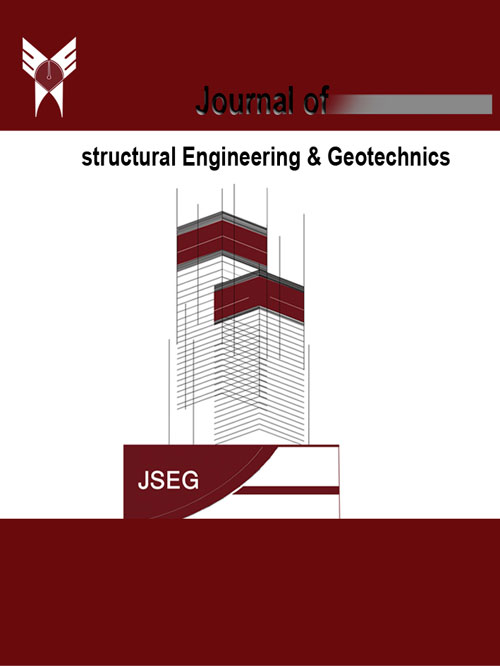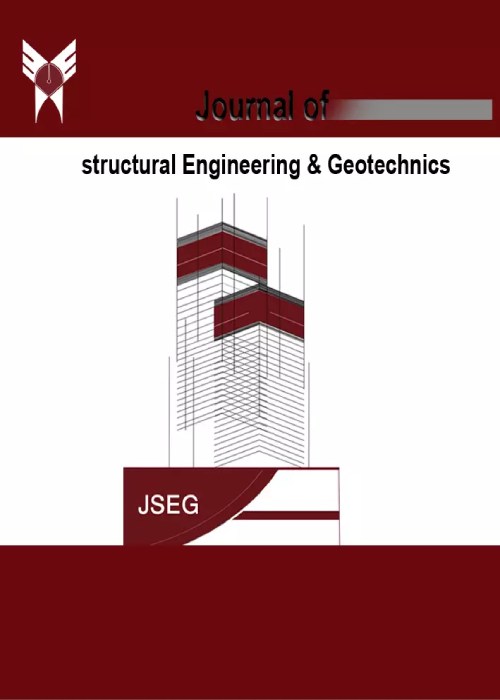فهرست مطالب

Journal of the Structural Engineering and Geotechnics
Volume:7 Issue: 2, Summer 2017
- تاریخ انتشار: 1396/05/15
- تعداد عناوین: 8
-
Pages 1-13Compressive strength and concrete slump are the most important required parameters for design, depending on many factors such as concrete mix design, concrete material, experimental cases, tester skills, experimental errors etc. Since many of these factors are unknown, and no specific and relatively accurate formulation can be found for strength and slump, therefore, the concrete properties can be improved to an acceptable level using the neural networks and genetic algorithm. In this research, having results of experimental specimens including soil classification parameters, water to cement ratio, cement content, super-lubricant content, compressive strength, and slump flow, using the MATLAB software, the perceptron neural network training, general regression neural network, and radial base function neural network are considered, and then, with regard to coefficient of determination (R2) criteria and mean absolute error, the above network.Keywords: Neural networks, Genetic Algorithm, Self, Compacting Concrete, Strength, Slump
-
Pages 15-26The soil-foundation interaction is one of the most important issues in geotechnical engineering that deals with studying the soil behavior subjected to the side loading. Winklers model is the first and simplest method for consideration of the soil-foundation interaction. It is vitally important to determine the coefficient of subgrade reaction of the soil. Since several methods have been provided to estimate the coefficient of subgrade reaction up to now, this research is conducted to choose a ground characteristic in Bandar Abbas (IRAN). To do so, the obtained results from the proposed experimental formulas are compared with corresponding values of the behavioral models to determine the coefficient of subgrade reaction. In addition finite element analysis is performed using Plaxis software. The result of this paper shows that the finite element method is more compatible than Biot's method. Results also showed an increasing footing diameter which leads to the decrease of the Ks. This fact is because of an increasing load area which concluded to the increasing of the settlement. It is found that with increasing each of the strength parameters of the soil ( ) can be expected an effect on increasing the subgrade reaction; although this increase depends on footing diameter. Also, in sand soils, the cohesion of the soil is more effective on the increase of the subgrade reaction coefficient than the internal friction angle.Keywords: Elasticity coefficient, Mat foundation, Subgrade reaction coefficient, Bandar Abbas City
-
Pages 27-36Given the development of construction industry and design and implementation of high rise buildings with complex sections and various geometrical forms, the use of self-compacting concretes has received the attention of construction engineers and provided great advantages. Due to the increasing air pollution in cities, governments encounter the important issue of repelling the pollutants in which construction industry plays a key role; so that recycled concrete has been suggested to decrease the construction pollutants. Therefore, self-compacting recycled concrete can take advantage of the both types of concrete and enormously benefit the environment by decreasing the use of natural aggregates and preventing from deterioration of natural mines The most important properties of good concrete include its workability, strength and durability. The range of these three properties is determined for the concrete made according to EFNARC, ASTM and BS through fresh concrete tests including slump flow, V-funnel, J-ring, L-box, compressive strength, capillary water absorption and water penetration under pressure and the following results are gained. Increasing the amount of recycled aggregates resulted in reduction of self-compacting concrete criteria like slump, J-ring, etc. which indicated decline of plasticity, workability, passing ability and so on and that might be because of grading variations. Compressive strength was dramatically reduced by increasing the amount of coarse recycled aggregate so that compressive strength of concrete specimens declined by 2-10% as the amount of recycled aggregate rose from 25% to 100%. Increasing the amount of recycled aggregates generally enhanced percentage of capillary water absorption; so that according to the results of tests, water absorption rose by 5-15% in specimens by increasing percentage of recycled aggregates, indicating an increase in permeability and a decrease in durability of concrete. The main propose of this article is to determine the optimum replacing percentage of recycled aggregates to find the best compressive strength and durability of self-compacting concrete. Therefore, different samples with replacing recycled aggregates by 0%, 25%, 50%, 75% and 100%, water to cement ratio of 0.35 and 0.45 and different amount of super- plasticizer were. The result shows that by increasing in the amount of recycled aggregates, the strength of concrete decreases while the permeability of concrete reduces.Keywords: Self, Compacting Concrete, recycled, Strength, Permeability, durability
-
Pages 37-50Characteristics of produced concrete become changedthrough changingthe characteristics of materials constituting the concrete. These changes include: The quality of cement, the real ration of water to cement: with neglecting the further water within the aggregates or lack of that, the consideredratio fluctuates and the characteristics of the aggregate which are related to the following dimensions: quality of aggregate, shape of aggregate and aggregate grading. The calculated strength in the mix design is the mean target strength which is marginally further than the specified strength. This further margin lowers the ration of water to cement in calculations and consequently, for a stable flow, the amount of consumption or alloy of cement in concrete increases. On the other hand, the amount of the margin depends on the following factors: The sensitivity level of the concrete project (with K coefficient) and standard deviation of concrete production. The purpose of defining this laboratory project is to obtain an optimal concrete mix design for different consumptions and consequently comparison of theoretical and workshop results in the mix design, lowering the cement consumption and the costs of concrete productions in batching and increasing or stabling the specified strength of concrete through lowering the level of cement consumed in concrete. In this procedure, concrete is produced through common method that is segregating sand from cement to compare that with the results obtained, and to calculate standard deviation fall, strength margin and cement alloy fall in order to produce concrete which is statistically suitable for the required strength.Keywords: standard deviation, specified strength, target strength, strength margin, project sensitivity coefficient
-
Pages 51-59Summary In this study, the seismic performance of hexagrid structures which are composed of horizontal and vertical hexagrid by using a transitional story, has been investigated. To this end, 10 models of 50-story hexagrid structures were designed. 9 models with horizontal hexagrid cells which transited to vertical cells using a transitional story, and a model of completely horizontal hexagrid have been designed. Finally, the seismic performance of these models were investigated and compared to the horizontal hexagrid structure to obtain the optimum location of the transitional story. According to the analyses results, combining horizontal and vertical hexagrid cells can strongly affect the seismic performance of the structure. Thus, choosing the optimum location of transitional story, regarding design priorities, is of significant importance.Keywords: hexagrid, tall building, seismic performance, nonlinear analysis
-
Pages 61-71Most of the existing concrete dams are subjected to cracking. These cracks are caused by various factors such as construction practices, curing, loads and volume change of mass concrete which reduce the efficiency, failure or instability of concrete dams. Using fracture mechanics as a new method to estimate stability and durability of concrete dams is recommended in scientific publications in worldwide. This study aimed to apply the principles and criteria of linear elastic fracture mechanics to evaluate the propagation of cracks in body and foundation of Kalat concrete gravity dam -that is located in the northern province of Khorasan Razavi, Iran- subjected to the worst-case loading, including the extraordinary loading case due to earthquake with full reservoir. For this purpose, ZENCRACK-v 7.7 and ABAQUS-v 6.10.1 software were utilized and nonlinear analysis of finite element are performed. Subsequently, linear elastic fracture mechanics criteria including stress intensity factor and maximum circumferential stress were calculated for existing cracks in various parts of dam body and foundation and stability of initial cracks, kinking angle and extension of them were determined. Based on the obtained results, crack propagation in areas near to both dam abutments is investigated. To do so, a plain strain condition is assumed that only expanded in longitudinal and transverse axes, but with being away from abutments toward dam center, crack growth logged from plain strain condition and expanded in the vertical direction. Also, under earthquake load with 10 second duration, maximum tension and compression stress were occurred between 2.32 to 4.26 seconds.Keywords: Fracture Mechanics, Stress intensity factor, Toughness, Concrete Dams, Cracks Propagation
-
Pages 73-83Soil reinforcement can be considered as the combination of two parts. One part is soil for compressive stress capacity and another part is some material such as geosynthetics such as steel belts and fibers for tensile stress capacity. Soil improvement is one of the useful methods to increase the strength parameters of the soil. The main goal of this study is to evaluate the effects of GFRP on the bearing capacity, shear strength, and permeability of clayey soil. For this purpose, the length of GFRP is selected 10 mm and amount of GFRP are 0.2, 0.4, 0.6, 0.8 and 1% that mixed randomly with clay. Mixture specimens prepared using the optimum water content. Bearing capacity of specimens measured by unconfined compressive test and direct shear test. Also, Permeability parameter assessed based on the falling head permeability test. Results of this study showed that with mixing GFRP up to 0.8% increases the clay bearing capacity and flexibility. Although with continuing to add GFRP the bearing capacity decrease, the clay permeability using GFRP is increased.Keywords: GFRP, Clayey soil, Angle of internal friction, Cohesion, Permeability
-
Pages 85-96Masonry infill walls are often used as non-structural elements. According to the past structural failure, ignorance of interaction between infill walls and enclosed frame may lead to the different seismic response for non-ductile building frames. The main contribution of this paper is to analytically investigate the behavior of reinforced concrete with masonry infill panels as participating structural. In doing so, a finite element model based on an equivalent strut method is conducted to represent the behavior of masonry panels. The strut model is calibrated using the results of the companion experimental program, which examined the cyclic behavior of infill panels with and without FRP sheets. Accordingly, a nonlinear spring element and a shell element are used to simulate the behavior of masonry strut elements and FRP sheets, respectively. The nonlinear static analysis (Push over analysis) is accomplished using SAP2000 [1] structural analysis software for a 10-story building with FRP sheets subjec.Keywords: Masonry infill, FRP sheet, Retrofit, Reinforced concrete, nonlinear analysis, seismic loading, finite element model


